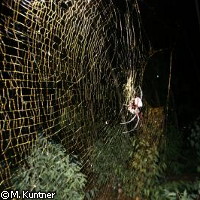Researchers find a not so itsy-bitsy spider in Africa
A new, giant Nephila species, commonly known as golden orb weaver spiders, makes its home in Africa and Madagascar, according to a Slovenian-US study. The results, published in PLoS (Public Library of Science) ONE, showed that this new species is the world's biggest ever orb weaver. The research was part of the NEPHILID SPIDERS ('Nephilid spider phylogenetics as a test for antagonistic coevolution of sexes') project, which received over EUR 766,000 under the 'Marie Curie International Reintegration Grants' (IRG) of the EU's Sixth Framework Programme (FP6). Over 41,000 spider species have been identified to date, and around 450 new species make this list each year. The golden orb weavers are unique in that their last valid description goes as far back as the 19th century. Researchers know that these spiders reign supreme when it comes to spinning the largest orb webs on Earth - diameters could reach a whopping one metre. However, these spiders are also model organisms for researchers investigating extreme sexual size dimorphism and sexual biology. Smithsonian research associate Matja� Kuntner, who is also Chairman of the Institute of Biology of the Slovenian Academy of Sciences and Arts, and his colleague Jonathan Coddington from the Smithsonian's National Museum of Natural History in the US, reconstructed size evolution in the spider family Nephilidae to demonstrate that the females of this new species are huge - their body length totals 3.8 centimetres and their leg span is between 10 to 12 centimetres - while the males are much smaller. While giant golden orb weavers are common in both the tropics and subtropics, and have been collected and are to be found in natural history museums, Dr Kuntner recognised only 15 valid species in his doctoral thesis. 'It was surprising to find a giant female Nephila from South Africa in the collection of the Plant Protection Research Institute in Pretoria, South Africa, that did not match any described species,' explained Dr Kuntner, who first examined the specimen in 2000. Drs Kuntner and Coddington, along with other researchers, conducted a series of expeditions to South Africa to find this species. Because their work did not bring in solid results, the researchers were led to believe that the Nephila specimen (first collected in 1978) was a hybrid or even an extinct species. Flash-forward to 2003, and a second specimen found in Madagascar indicated that it was not a hybrid. But no other specimens materialised in their investigations of 2,500 samples. The evidence pointed to the species' extinction. However, thanks to the persistence of a South African colleague, one male and two females were discovered in Tembe National Elephant Park in South Africa. The result? The validation of a new species called Nephila komaci, named after Dr Kuntner's best friend Andrej Komac, who died in an accident at the time of these discoveries. 'My friend, himself a scientist, encouraged me to tackle this PhD, but did not live to see the discoveries made,' Dr Kuntner said. 'He was a big inspiration, and a great friend, thus it was logical to name this new species [in] his memory.' Drs Kuntner and Coddington are hoping to find new populations of N. komaci in Africa or Madagascar. Their work would fuel greater research on the group, particularly because the species seems to be very rare, according to them. 'We fear the species might be endangered, as its only definite habitat is a sand forest in Tembe Elephant Park in KwaZulu-Natal,' Dr Coddington said. 'Our data suggest that the species is not abundant, its range is restricted and all known localities lie within two endangered biodiversity hotspots: Maputaland and Madagascar.' The genus name Nephila is derived from Ancient Greek and means 'fond of spinning' (nen = to spin and philos = love).
Countries
Slovenia



